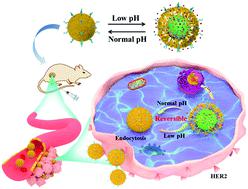当前位置:
X-MOL 学术
›
Nanoscale Horiz.
›
论文详情
Our official English website, www.x-mol.net, welcomes your
feedback! (Note: you will need to create a separate account there.)
Reversibly-regulated drug release using poly(tannic acid) fabricated nanocarriers for reduced secondary side effects in tumor therapy.
Nanoscale Horizons ( IF 8.0 ) Pub Date : 2020-04-02 , DOI: 10.1039/d0nh00032a Chao Chen 1 , Tonghao Ma , Wen Tang , Xiaoli Wang , Yibing Wang , Jiafeng Zhuang , Yucheng Zhu , Ping Wang
Nanoscale Horizons ( IF 8.0 ) Pub Date : 2020-04-02 , DOI: 10.1039/d0nh00032a Chao Chen 1 , Tonghao Ma , Wen Tang , Xiaoli Wang , Yibing Wang , Jiafeng Zhuang , Yucheng Zhu , Ping Wang
Affiliation

|
Numerous nanocarriers with pH-responsive properties have been designed and fabricated to reduce the adverse side effects of traditional chemotherapeutics, but these traditional nanocarriers are rarely reversible; this may cause “secondary” side effects on normal tissues, because the nanocarriers cannot be sealed again to prevent the leakage of incompletely released drugs after re-entering blood circulation. To overcome these limitations, we report herein the synthesis of a reversibly pH-responsive drug delivery system, which can achieve regulated drug release in a “release-stop-release” manner corresponding to changes in pH. Specifically, poly(tannic acid) as the “gatekeeper” was firstly deposited and polymerized on the surface of mesoporous silica nanoparticles (MSNs) via a modified mussel-inspired method similar to dopamine, and the formed polymer shell can be easily decorated with a targeting ligand HER2 antibody for the selective delivery of drugs to specific cells. The resulting nanocomposites exhibited good colloidal stability, good biocompatibility, high drug loading capacity and accurate HER2 antibody mediated targeting ability. Interestingly, a series of experiments fully demonstrated that the fabricated nanocomposites possessed intelligent reversible pH-responsive controlled release behavior through adjusting the density of the “gatekeeper” under different pH conditions, thereby achieving reversible switching from “on” to “off”. Furthermore, in vitro and in vivo experiments verified that the fabricated targeting nanoparticles could efficiently inhibit tumor growth with minimal side effects. Meanwhile, these nanocarriers exhibited excellent reusability, in vitro cytotoxicity and minimal in vivo myocardial damage. Collectively, the reversible pH-operated nanovalve on the MSNs constructed here could serve as a nanoplatform to solve the problem of “secondary” side effects caused by residual drugs in irreversible “gatekeeper” systems.
中文翻译:

使用聚鞣酸制备的纳米载体可逆调节药物释放,以减少肿瘤治疗中的次要副作用。
已经设计和制造了许多具有pH响应特性的纳米载体,以减少传统化学疗法的不利副作用,但是这些传统纳米载体很少可逆。这可能会对正常组织造成“次要”副作用,因为纳米载体无法再次密封以防止未完全释放的药物在重新进入血液循环后泄漏。为了克服这些局限性,我们在此报告了一种可逆的pH响应药物传递系统的合成,该系统可以实现与pH值变化相对应的“释放-停止-释放”方式的调节药物释放。具体而言,首先将聚单宁酸作为“守门员”沉积并通过介孔二氧化硅纳米粒子(MSNs)进行聚合。一种类似于多巴胺的改良贻贝启发性方法,并且可以用靶向配体HER2抗体轻松修饰形成的聚合物外壳,以选择性地将药物递送至特定细胞。所得纳米复合材料表现出良好的胶体稳定性,良好的生物相容性,高载药量和准确的HER2抗体介导的靶向能力。有趣的是,一系列实验充分证明,通过在不同pH条件下调节“关守”的密度,纳米复合材料具有智能的可逆pH响应控释行为,从而实现了从“开”到“关”的可逆转换。此外,在体外和体内实验证明,制备的靶向纳米颗粒可以有效抑制肿瘤生长,且副作用最小。同时,这些纳米载体表现出优异的可重复使用性,体外细胞毒性和最小的体内心肌损伤。总体而言,在此构建的MSN上可逆pH值操作的纳米阀可以用作纳米平台,以解决不可逆的“关守”系统中残留药物引起的“次级”副作用的问题。
更新日期:2020-04-02
中文翻译:

使用聚鞣酸制备的纳米载体可逆调节药物释放,以减少肿瘤治疗中的次要副作用。
已经设计和制造了许多具有pH响应特性的纳米载体,以减少传统化学疗法的不利副作用,但是这些传统纳米载体很少可逆。这可能会对正常组织造成“次要”副作用,因为纳米载体无法再次密封以防止未完全释放的药物在重新进入血液循环后泄漏。为了克服这些局限性,我们在此报告了一种可逆的pH响应药物传递系统的合成,该系统可以实现与pH值变化相对应的“释放-停止-释放”方式的调节药物释放。具体而言,首先将聚单宁酸作为“守门员”沉积并通过介孔二氧化硅纳米粒子(MSNs)进行聚合。一种类似于多巴胺的改良贻贝启发性方法,并且可以用靶向配体HER2抗体轻松修饰形成的聚合物外壳,以选择性地将药物递送至特定细胞。所得纳米复合材料表现出良好的胶体稳定性,良好的生物相容性,高载药量和准确的HER2抗体介导的靶向能力。有趣的是,一系列实验充分证明,通过在不同pH条件下调节“关守”的密度,纳米复合材料具有智能的可逆pH响应控释行为,从而实现了从“开”到“关”的可逆转换。此外,在体外和体内实验证明,制备的靶向纳米颗粒可以有效抑制肿瘤生长,且副作用最小。同时,这些纳米载体表现出优异的可重复使用性,体外细胞毒性和最小的体内心肌损伤。总体而言,在此构建的MSN上可逆pH值操作的纳米阀可以用作纳米平台,以解决不可逆的“关守”系统中残留药物引起的“次级”副作用的问题。









































 京公网安备 11010802027423号
京公网安备 11010802027423号